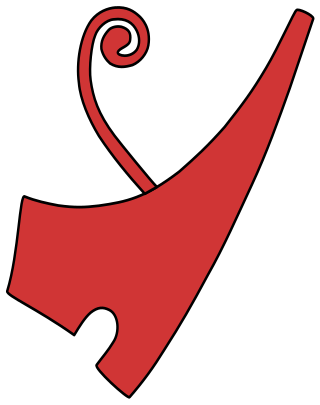
Deshret was the Red Crown of Lower Egypt. When combined with the Hedjet of Upper Egypt, it forms the Pschent, in ancient Egyptian called the sekhemti.
The ancient Egyptian Harpoon,, is one of the oldest language hieroglyphs from ancient Egypt. It is used on the famous Narmer Palette of Pharaoh Narmer from the 31st century BC, in an archaic hieroglyphic form.

The ancient Egyptian Mast hieroglyph is one of the oldest language hieroglyphs from Ancient Egypt. It is used on a famous label of Pharaoh Den of the First dynasty, but forms part of the location hieroglyph: Emblem of the East.
The ancient Egyptian horizontally-outstretchedArm with powerstick is a hieroglyph with the meaning of "force", or "power of action". As a baton, or macehead. Power is obvious, but the origins may have also had references to magic, or the idea of driving-off evil spirits or omens.
The Walking Legs-forward is an ancient Egyptian language hieroglyph of the concept of action, part of "going and returning". Walking Legs-returning is the other half.
In ancient Egyptian hieroglyphs, the hand symbol represented the phoneme /d/, and was also used as a determinative for actions performed as if with the hands.
The ancient Egyptian Dua hieroglyph is one of a series of language and visual hieroglyphs used from the earliest dynasties of Ancient Egypt, and that portrays men, women, ideology, and some occupations.
The Foreleg of ox hieroglyph of ancient Egypt is a hieroglyph; it is the nighttime constellation Ursa Major called as Maskheti constellation. It came to have many uses in ancient Egypt over its entire history.
The Throw stick hieroglyph of ancient Egypt is an old hieroglyph that dates from the Predynastic Period; it is from the assemblage of hieroglyphs used on the ornamental, or ceremonial cosmetic palettes. It is used on the palettes both as a throwing-stick weapon in the animal hunt being portrayed-(the Hunters Palette), as well as on certain palettes, as a determinative referring to a "foreigner", or "foreign territory".
The ancient Egyptian Papyrus stem hieroglyph is one of the oldest language hieroglyphs from Ancient Egypt. The papyrus stalk, was incorporated into designs of columns on buildings, also facades, and is also in the iconographic art portrayed in ancient Egyptian decorated scenes.
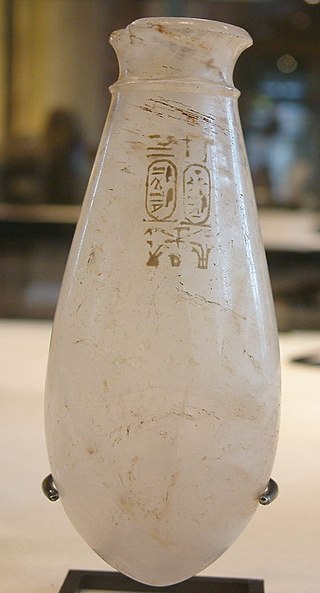
The ancient Egyptian Bowstring hieroglyph is an Egyptian language hieroglyph associated with the bow, and its use as a hieroglyph for the Archer hieroglyph, a symbol for 'army'. Because of the strength required to "string a bow", with a bow string, the bowstring hieroglyph is used to define words of strength, hardness, durability, etc.
The ancient Egyptian Branch hieroglyph, also called a Stick, is a member of the trees and plants hieroglyphs.
The ancient Egyptian Brazier hieroglyph is Gardiner sign listed no. Q7 for the cooking brazier. It is shown from the Old Kingdom in the style of a vertical burning flame upon four feet, but the hieroglyph has the flame hiding the fourth foot. Another Gardiner unlisted form has the four feet, with no flame, and in a plan view.
The Ancient Egyptian Swallow hieroglyph is Gardiner sign listed no. G36 for swallow birds. The Sparrow hieroglyph appears similar in size and shape, but it is used to represent small, or bad items.
The ancient Egyptian Grape arbor hieroglyph is Gardiner sign listed no. M43 in Gardiner's subcategory for trees and plants. The hieroglyph shows a horizontal vine with stylized bunches suspended below; each end is supported by the hieroglyph for a "prop", Gardiner no. O30,
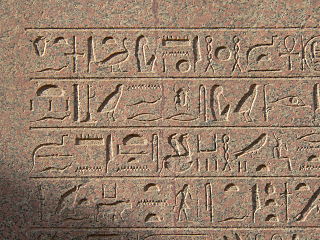
The ancient Egyptian Two Whips with Shen ring hieroglyph, Gardiner sign listed no. S23 is a portrayal of the Shen ring with two Egyptian flails-(Crook and flail); it is a member of the Gardiner subset for "crowns, dress, staves, etc".

The Egyptian hieroglyph ndj (nḏ) has the shape of a cross. It presumably depicts some type of tool such as a mill. It is often written alongside the nu "pot" hieroglyph (W24). It is used as an ideogram or determinative in the context of "grains", "grinding stone", "grind", "to rub out".
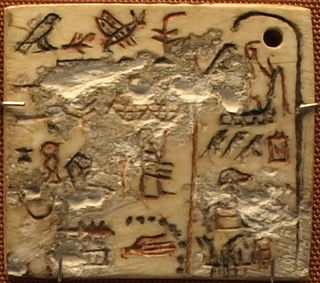
The ancient Egyptian Hand-with-droplets hieroglyph, Gardiner sign listed no. D46A is a portrayal of the hand, with droplet offerings. In the Old Kingdom usage it is found on ivory labels and slab stelas, presumably with the use of 'aroma' and unguents, or with incense. As the verb usage with 'libation', water or liquids are involved.
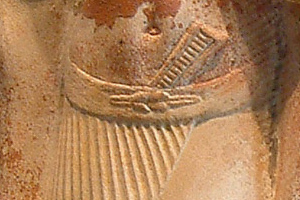
The ancient Egyptian knot hieroglyph, or girdle knot, Gardiner sign listed no. S24, portrays a reef knot. Besides its use as a hieroglyph, it has usage in statuary and reliefs. The knot hieroglyph is also an amulet, typically made of worked stone, or as jewellery elements.

The ancient Egyptian Obelisk hieroglyph, Gardiner sign listed no. O25 is a portrayal of the obelisk. The hieroglyph is commonly used on erected Egyptian obelisks, as there is often a discussion of the event of its erection: a historical event, as well as an accomplishment of the pharaoh, and the Egyptian Kingdom.









